The NVIDIA GeForce GTX 780 Ti Review
by Ryan Smith on November 7, 2013 9:01 AM ESTOverclocking
Finally, let’s spend a bit of time looking at the overclocking prospects for the GTX 780 Ti. Although GTX 780 Ti is now the fastest GK110 part, based on what we've seen with GTX 780 and GTX Titan there should still be some headroom to play with. Meanwhile there will also be the matter of memory overclocking, as 7GHz GDDR5 on a 384-bit bus presents us with a new baseline that we haven't seen before.
| GeForce GTX 780 Ti Overclocking | ||||
| Stock | Overclocked | |||
| Core Clock | 876MHz | 1026MHz | ||
| Boost Clock | 928MHz | 1078MHz | ||
| Max Boost Clock | 1020MHz | 1169MHz | ||
| Memory Clock | 7GHz | 7.6GHz | ||
| Max Voltage | 1.187v | 1.187v | ||
Overall our overclock for the GTX 780 Ti is a bit on the low side compared to the other GTX 780 cards we’ve seen in the past, but not immensely so. With a GPU overclock of 150MHz, we’re able to push the base clock and maximum boost clocks ahead by 17% and 14% respectively, which should further extend NVIDIA’s performance lead by a similar amount.
Meanwhile the inability to unlock a higher boost bin through overvolting is somewhat disappointing, as this is the first time we’ve seen this happen. To be clear here GTX 780 Ti does support overvolting – our card offers up to another 75mV of voltage – however on closer examination our card doesn’t have a higher bin within reach; 75mV isn’t enough to reach the next validated bin. Apparently this is something that can happen with the way NVIDIA bins their chips and implements overvolting, though this the first time we’ve seen a card actually suffer from this. The end result is that it limits our ability to boost at the highest bins, as we’d normally have a bin or two unlocked to further increase the maximum boost clock.
As for memory overclocking, we were able to squeeze out a bit more out of our 7GHz GDDR5, pushing our memory clock 600MHz (9%) higher to 7.6GHz. Memory overclocking is always something of a roll of the dice, so it’s not clear here whether this is average or not for a GK110 setup with 7GHz GDDR5. Given the general drawbacks of a wider memory bus we wouldn’t be surprised if this was average, but at the same time in practice GK110 cards haven’t shown themselves to be as memory bandwidth limited as GK104 cards. So 9%, though a smaller gain than what we’ve seen on other cards, should still provide GTX 780 Ti with enough to keep the overclocked GPU well fed.
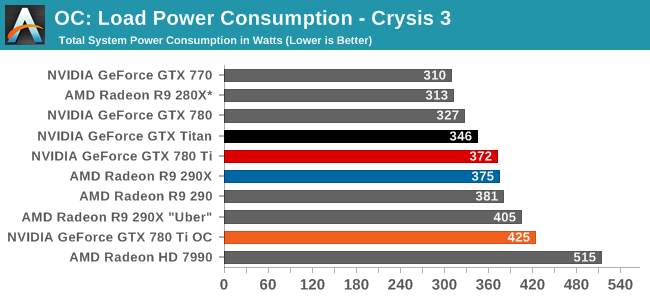
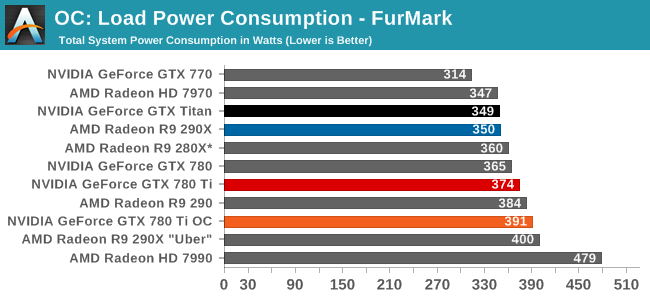
Starting as always with power, temperatures, and noise, we can see that overclocking GTX 780 Ti further increases its power consumption, and to roughly the same degree as what we’ve seen with GTX 780 and GTX Titan in the past. With a maximum TDP of just 106% (265W) the change isn’t so much that the card’s power limit has been significantly lifted – as indicated by FurMark – but rather raising the temperature limit virtually eliminates temperature throttling and as such allows the card to more frequently stay at its highest, most power hungry boost bins.
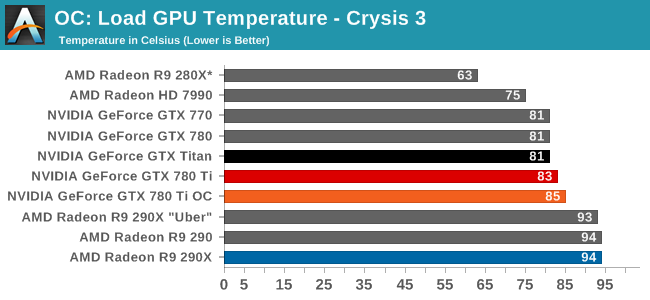

Despite the 95C temperature target we use for overclocking, the GTX 780 Ti finds its new equilibrium point at 85C. The fan will ramp up long before it allows us to get into the 90s.
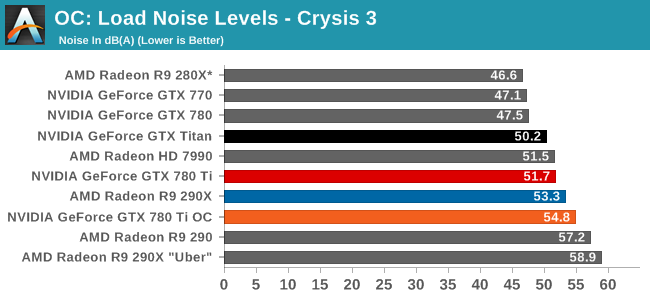
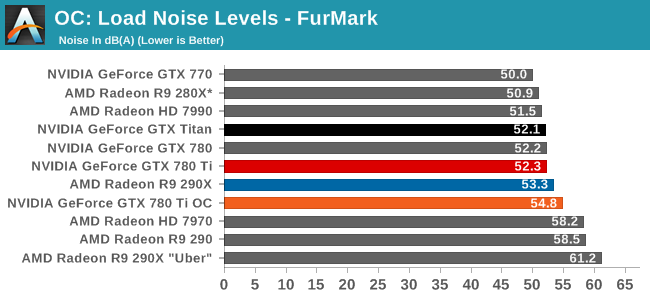
Given the power jump we saw with Crysis 3 the noise ramp up is surprisingly decent. A 3dB rise in noise is going to be noticeable, but even in these overclocked conditions it will avoid being an ear splitting change. To that end overclocking means we’re getting off of GK110’s standard noise efficiency curve just as it does for power, so the cost will almost always outpace the payoff on a relative basis.
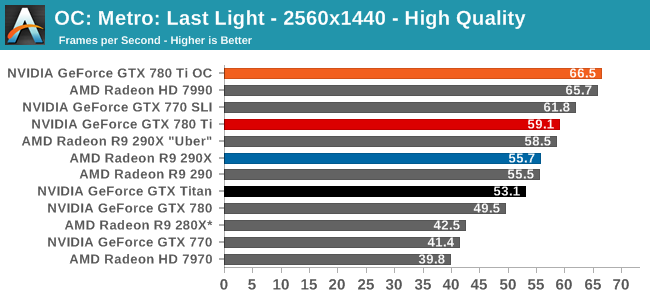
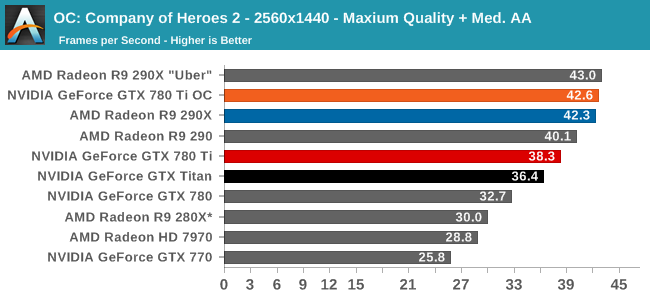
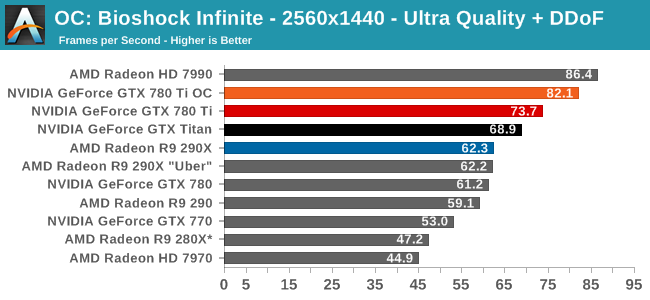
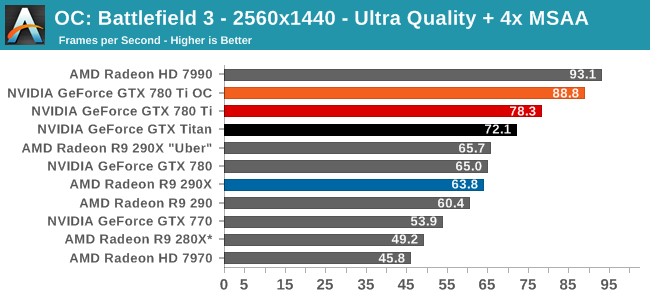
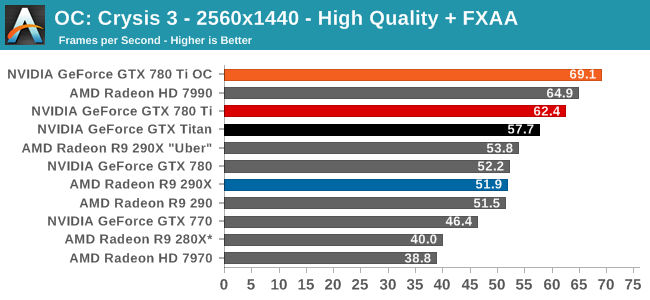
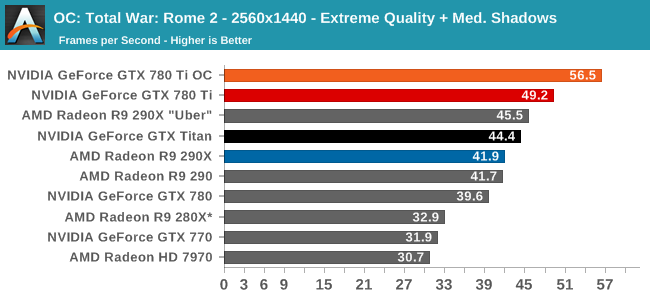
Finally, looking at gaming performance the the overall performance gains for overclocking are generally consistent. Between our 6 games we see a 10-14% performance increase, all in excess of the memory overclock and closely tracking the GPU overclock. GTX 780 Ti is already the fastest single-GPU card, so this only further improves its performance lead. But it does so while cutting into whatever is above it, be it the games where the stock 290X has a lead, or multi-GPU setups such as the 7990.










302 Comments
View All Comments
polaco - Friday, November 8, 2013 - link
Indeed that's exactly the way I see it. AMD has played it's cards quite well this time. NVidia seems to be on it's price knees and can't compete any way. NVidia needs a new GPU to compete with Hawaii. I don't want to put into cosideration Mantle, TrueAudio, Gsync nor the Shield discount.Mantle and TrueAudio hasn't been demoed yet.
Shield seems like a waste of money and almost useless for me.
Maybe in a future if they prove to be worthy we will see Mantle, TrueAudio and Gsync to be included as part of an upgrade other standards.
Gigaplex - Sunday, November 10, 2013 - link
Only 5% faster than a $1000 card? Yeah, totally overpriced at $700.Sarcasm aside, it really is overpriced. But comparing it to the Titan to justify that claim doesn't work.
polaco - Friday, November 8, 2013 - link
Well looking at Anand's benchmarks I can't find a way to justify spending such amount of money on this card. AMD 290 and 290X looks way more interesting. As difference to others reviews Anand's has focused only in ultra high resolutions I think that's the way to go. Since no one would buy one of this cards (780ti, 290X) to game at 1680x1050. So at this high resolutions performances differences between the cards are barely minimal in most cases and could be reduced even more by drivers updates or settings tunning. I find no reason to spend such a difference for 780 Ti while having more than decent performance from radeon 290 at 250 bucks less. If I would want to go to an extreme instead of aquiring a 780Ti it would be better and get 2xradeon290 for 100 bucks more. So the problem of 780Ti is it's price, pure and simple. I really find difficult NVidia could lower the prices more since it looks 290 and 290X launch has putted NVidia prices to it's knees. So far I'm still waiting for 290, 290X third party coolers if they are good they can even pair or overcome 290 and 290X performance against 780Ti. What I have no doubt is how Titan and 780 early buyers must be feeling at this moment...j6z7 - Friday, November 8, 2013 - link
I think the majority of comments here reveals the truth behind big headlines with reviews.The reference 290X with 10 year old reference cooler still beating the 780ti with best cooler in CF - and it does it being $300 cheaper too!
If anything, Nvidia shot itself in the foot against its own Titan.
Nvidia fans will continue to support the company in ripping people off, while AMD provides same performance at affordable prices.
End of the day, people who'll buy the 290X will be much more satisfied customers.
The End.
Mondozai - Friday, December 13, 2013 - link
Nvidia fanboys like EJS1980 are like battered wives. They are trying to rationalize themselves being raped.b3nzint - Friday, November 8, 2013 - link
You must be pissed with 290x being priced that low. Anyway AMD should reconsider for using that blower type fan. Nvidia have better cooling system than AMD, but for that price i just don't care. For $700? still too much.b3nzint - Friday, November 8, 2013 - link
what about mantle, compute power and trueaudio? u don't buy gpu for just friggin fps number!wwwcd - Friday, November 8, 2013 - link
WoW Ryan cut my comment. I know he is a really hard green fen, but this censor not placed with democracy. I can revenge of m-r Anand!Ryan Smith - Friday, November 8, 2013 - link
Uh, we haven't deleted anything. Are you sure you haven't just misplaced your comment?not_there - Friday, November 8, 2013 - link
I'm not a gamer, but I like to put a decent video card in my builds to run Folding@Home. It's real science and it helps heat my basement. Reading the reviews here I'm confused (someone point out what I'm missing). In a June review of the GTX 760 the Radeon HD 7970 got a 36.1 and in this review, the same card on the same test got a 29.3. This was the Folding@Home Explicit, Single Precision benchmark. June number for the GTX 770 in this test was 35.6 and in the same test on the same card in this review the benchmark is 15.1. Why the difference?